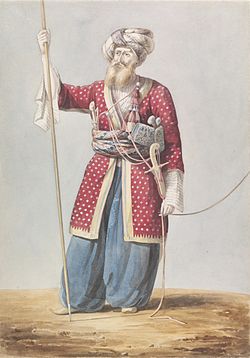Mamluker
- För andra betydelser se Mameluckerna


Mamluker (arabiska "ägd"), tidigare ghilman, singular ghulam ("pojke"),[1] var slavsoldater som användes av de muslimska kaliferna och andra islamiska härskare i Orienten. Mamluker tillskansade sig makten själva vid mer än ett tillfälle. Så skedde till exempel i Egypten i mitten av 1200-talet då en av slavar bestående livvakt åt sultanen grep makten i landet och bildade mamluksultanatet i Egypten vilket existerade ända fram till osmanernas erövring 1517, samt även i Delhisultanatet på 1200-talet (se vidare mamlukdynastin i Delhi).
Bakgrund
Islamiska härskare rekryterade till stor del slavar till sin armé, vilket var ett sätt att lösa lojalitetsproblemet inom furstens välde. Furstarna var alltid tvungna att hävda sin ställning och de enda som de ansåg sig kunna lita på var slavar varmed menades främlingar utan familjeband som personligen var knutna till fursten genom att de ägdes av honom. I Europa under medeltiden löste man lojalitetsproblemet genom feodalismens trohetsförhållande mellan länsherre och vasall, medan man i Orienten löste detta genom förhållandet ägare – slav.
Rekrytering
Då den islamiska rätten förbjöd att den som var född muslim gjordes till slav var man tvungen att erhålla slavar från ännu icke-islamiska områden som Sydryssland och Kaukasus. Slavhandeln sköttes nästan uteslutande av venetianska köpmän och så småningom på 1300-talet av genuesarna vilkas koloni Kaffa på Krim blev en av de största slavmarknaderna i Orienten. Dessa slavar utbildades till soldater och kallades mamluker (ordagrant ägd). Många av dessa steg i graderna och innehade höga ämbeten både i armén och förvaltningen och försörjdes med inkomsterna från förläningar.
Se även
Referenser
- Den här artikeln är helt eller delvis baserad på material från engelskspråkiga Wikipedia, Mamluk, 3 september 2015.
Media som används på denna webbplats
The Mamluks (literally `owned’, i.e., slaves) had controlled Egypt from 1250 until the Ottoman conquest of 1516-17, yet even then they still continued to govern Egypt for the Ottoman Sultan, while paying tribute. Originally they had been a military caste of former slaves serving the Egyptian sultans. Young boys, mainly Kipchak Turks from regions north of the Black Sea, were bought from slave dealers and trained as warriors by previous generations of Mamluk amirs or commanders. They were set free on reaching adulthood, given a horse and arms, and then took employment with their former masters. In 1250, a group of Mamluk generals seized power from the Ayyubid dynasty, and ruled Egypt, even after the Ottoman conquest, until the time of Napoleon’s invasion in 1797. Under the Mamluk Sultan Baybars, they had even defeated the Mongols in a pitched battle in 1260. Although to the end spectacularly brave horsemen, their power slowly declined. The Egyptian economy was weakened by the rise of European trading rivals and new trade routes, and by devastating visitations of the plague. After surviving the invasion by the French, and then the British, the Mamluks struggled on. Yet, apart from a few survivors, the most prominent were finally eliminated in a treacherous massacre by the new ruler of Egypt, the Albanian general Muhammad Ali in 1811.
This is one of twenty-one costume figure studies, probably intended for illustration, by Page in the Museum’s collections. They show Ottoman subjects of various ranks and occupations, both male and female. Page recorded in fine detail their elaborate costumes in the last years preceding the modernising reforms that steadily eroded many traditional forms of dress and behaviour. It is not clear how many Mamluks survived the massacre by Muhammad Ali in 1811, but the detail of the costume of this individual, and that it seems to be a kind of portrait, implies that Page saw this survivor first-hand. Unlike Henry Alken’s preoccupation with horses [See SD.17], Page has focused his attention on the remarkable costume, including the embroidered shawl round the waist and the distinctive turban. The fact that he was a horseman is only suggested by the rope he is holding, and the long lance that had made the Mamluks so feared in battle.
Painting of a Mamluk. Trans: "Mamluk, in typical attire."

